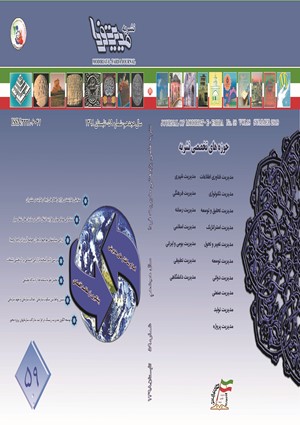مطالعه سایبرلوفینگ (استفاده بی مورد از اینترنت) در محیط کار و اثر آن بر بهرهوری کارکنان
الموضوعات :اکبر بهمنی 1 , رمضان غلامی اواتی 2
1 - دانشگاه پیام نور
2 - پیام نور
الکلمات المفتاحية: سایبرلوفینگ, محیط کار, بهره¬, وری, شرکت زمزم.,
ملخص المقالة :
هدف از پژوهش حاضر تحلیل سایبرلوفینگ (استفاده بی مورد از اینترنت) در محیط کار و اثر آن بر بهرهوری کارکنان می باشد. پژوهش حاضر از لحاظ هدف، در گروه تحقیقات کاربردی قرار گرفته و از جهت روش، تحقیق توصیفی و در زمره تحقیقات پیمایشی قرار می گیرد. جامعه آماری در این پژوهش شامل کارکنان شرکت زمزم به تعداد 1300 نفر میباشد. حجم نمونه آماری پژوهش با استفاده از قانون 10 معادلات ساختاری بدست آمد که تعداد 350 نفر به صورت طبقه ای دردسترس به عنوان نمونه انتخاب شدند. ابزار گردآوری اطلاعات پرسشنامه میباشد که پایایی پرسشنامه با استفاده از ضریب آلفای کرانباخ و پایایی ترکیبی، و روایی پرسشنامه با استفاده از روایی همگرا و روایی محتوا با استفاده از نظر متخصصان آشنا به موضوع پژوهش مورد تایید قرار گرفت. همچنین برای تعیین رابطه و تجزیه و تحلیل دادهها از نرم افزار SPSS22 و Lisrel8.8 استفاده شده است. نتایج حاصل از تجزیه و تحلیل دادهها منجر به تایید همهی فرضیههای پژوهش گردید: عوامل شخصیت، الزامات شغلی، تضاد شغل، سیاست های سازمانی، و عدالت سازمانی بر سایبرلوفینگ تاثیر معنادار دارند. همچنین نتایج بیان میکند که سایبرلوفینگ سبب کاهش میزان بهره وری افراد در شرکت می شود.
1. فرشته کاکلیان. (1392). بررسی پیامدهای مثبت سایبرلوفینگ در دانشگاه های شهرستان بابل. پایاننامه کارشناسی ارشد، موسسه آموزش عالی مهرالبرز
2. موسوی ارفع، مریم هنگامه و روحانی، سعید. (1392). بررسی و علل سایبرلوفینگ. رسانه و فرهنگ. سال سوم. شماره اول. بهار و تابستان 1392
3. Ahmadi, H. and F. Bagheri and S. A. Ebrahimi and M. NejadRokni and A. Safari and M. Kahrah (2011). ‘Deviant Work Behavior: Explaining Relationship between Organizational Justice and Cyber-Loafing as a Deviant Work Behavior’, Euro Journals Publishing, Vol. 24.
4. Ayşe Esmeray yogun. (2015). Cyberloafing and innovative work behavior among banking sector employees. International Journal of Business and Management Review. Vol.3, No.10, pp.61-71, November 2015.
5. Best, J., (1994), research methods in humanities, (Pasha Sharifi, H., Taleqani, N.) Tehran: Roshd Pub., 5thEd., p: 24.
6. Caplan, S.E. (2002). “Problematic Internet use and psychosocial well-being: development of a theory-based cognitive-behavioural measurement instrument”. Computers in Human Behaviour, 18, 553-575.
7. Freimark, O. (2012). The role of organizational citizenship behavior and organizational justice on intention to cyberloaf through a general deterrence. A dissertation submitted in partial fulfillment of the requirements for the doctor of philosophy degree in business administration.
8. Ahmad Aliyu Palladan(2018) Moderating Effects of Cyberloafing Activity on Innovative Work Behaviour and Lecturers Job Performanc,International Journal of Advanced Studies in Social Science & Innovation (IJASSI),vol2,no 1,pp28-49
9. .Lim,vivien and chen don(2012) Cyber loafing at the workplace: Gain or drain on work?, Research Collection Lee Kong Chian School Of Business, vol31,issu4,pp343-353
10. van Doorn(2011) Cyberloafing: A multidimensional construct placed in a theoretical
framework ,Industrial Engineering and Management Science, Department Industrial Engineering and Innovation Sciences.Series Master Theses Innovation Managemen, August 2011
11. Blanchard, L. A., & Henle, A. C. (2008). Correlates of different forms of cyber loafing:. Computers in Human Behavior,vol., 24, p.p. 1067–1084
12. Henle, A. C., & Blanchard, L. A. (2017). The Interaction of Work Stressors and Organizational Sanctions on Cyber loafing. Journal of Managerial Issues ,vol., 20, p.p.383-400
13. Meyer, P. J., Stanley, J. D., Jackson, A. T., McInnis, J. K., Maltin, R. E., & Sheppard, L. (2012). Affective, normative, and continuance commitment levels across cultures: A meta-analysis. Journal of ocational Behavior, vol., 80, p.p.225–245.
14. Farmer, J. S., Beehr, A. T., & Love, G. K. (217). Becoming an undercover police officer: a note on fairness perceptions, behavior, and attitudes. Journal of Organizational Behavior, vol., 24, p.p. 373-387


